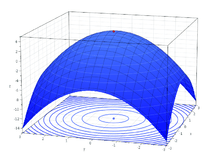Davidon–Fletcher–Powell formula
The Davidon–Fletcher–Powell formula (or DFP; named after William C. Davidon, Roger Fletcher, and Michael J. D. Powell) finds the solution to the secant equation that is closest to the current estimate and satisfies the curvature condition (see below). It was the first quasi-Newton method to generalize the secant method to a multidimensional problem. This update maintains the symmetry and positive definiteness of the Hessian matrix.
Given a function  , its gradient (
, its gradient ( ), and positive definite Hessian matrix
), and positive definite Hessian matrix  , the Taylor series is:
, the Taylor series is:
and the Taylor series of the gradient itself (secant equation):
is used to update  .
The DFP formula finds a solution that is symmetric, positive definite and closest to the current approximate value of
.
The DFP formula finds a solution that is symmetric, positive definite and closest to the current approximate value of  :
:
where
and  is a symmetric and positive definite matrix.
The corresponding update to the inverse Hessian approximation
is a symmetric and positive definite matrix.
The corresponding update to the inverse Hessian approximation  is given by:
is given by:
 is assumed to be positive definite, and
the vectors
is assumed to be positive definite, and
the vectors  and
and  must satisfy the curvature condition:
must satisfy the curvature condition:
The DFP formula is quite effective, but it was soon superseded by the BFGS formula, which is its dual (interchanging the roles of y and s).
See also
- Newton's method
- Newton's method in optimization
- Quasi-Newton method
- Broyden–Fletcher–Goldfarb–Shanno (BFGS) method
- L-BFGS method
- SR1 formula
- Nelder–Mead method
References
- Davidon, W. C. (1991), "Variable metric method for minimization", SIAM Journal on Optimization 1: 1–17, doi:10.1137/0801001
- Fletcher, Roger (1987), Practical methods of optimization (2nd ed.), New York: John Wiley & Sons, ISBN 978-0-471-91547-8.
- Nocedal, Jorge & Wright, Stephen J. (1999), Numerical Optimization, Springer-Verlag, ISBN 0-387-98793-2
| |||||||||||||||||||||||||||||||||||||||||||||||||||||||||||||||||||||||||||||||||||||||||||||||||||||||||||||







